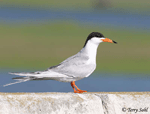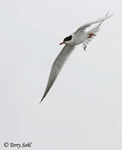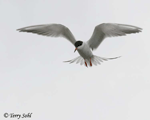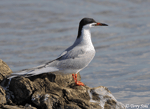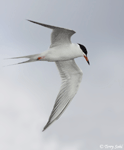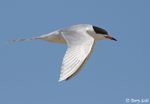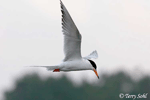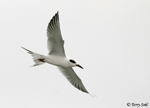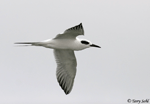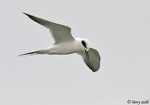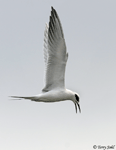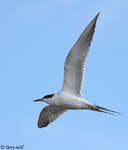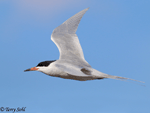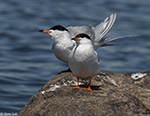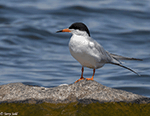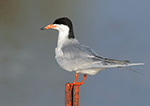| Length: 15 inches | Wingspan: 30 inches | Seasonality: Summer / Migrant |
| ID Keys: Black cap and nape, deeply forked tail, white underparts, pale gray upperparts, orange-red bill, legs, and feet. | ||
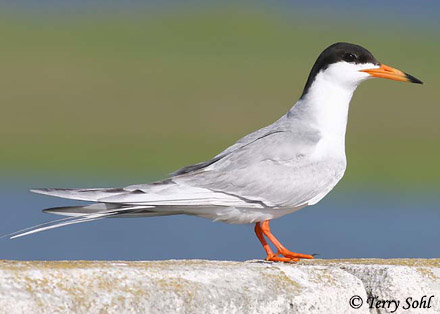 Forster's
Terns are generally the most common
of the black-capped, gray-backed, white bodied terns found in the state.
Very similar to the Common Tern, the Forster's Tern is also the more common breeder
in the state, generally being found around freshwater marshes, and often nesting
on the top of muskrat houses. Differentiating between Forster's Terns
and Common Terns can be difficult unless seen well (see identification tips down
below). Forster's Terns may also sometimes be seen with
Black Terns, with mixed nesting colonies of
the two species relatively common.
Forster's
Terns are generally the most common
of the black-capped, gray-backed, white bodied terns found in the state.
Very similar to the Common Tern, the Forster's Tern is also the more common breeder
in the state, generally being found around freshwater marshes, and often nesting
on the top of muskrat houses. Differentiating between Forster's Terns
and Common Terns can be difficult unless seen well (see identification tips down
below). Forster's Terns may also sometimes be seen with
Black Terns, with mixed nesting colonies of
the two species relatively common.
Habitat:
In summer, primarily large freshwater marshes on the interior of the country, or salt marshes along the coasts. In winter, many aquatic habitats along the coasts.
Diet:
Primarily fish, but will also eat insects, small crustaceans and mollusks, frogs, and tadpoles.
Behavior:
Forages by flying slowing over water or hovering, dipping down to snag sighted fish below the surface. They will also sometimes capture flying insects in mid-air.
Nesting:
June and July in South Dakota. The nest of a Forster's Tern is typically placed on the ground in the cover of vegetation, including dead marshland vegetation, nearby meadow grasses, or even on the top of a Muskrat lodge. The nest consists of a small platform of grasses, lined with finer vegetative material. The female lays between 1 and 3 eggs, with both sexes helping to incubate them. The young hatch after about 24 days.
Song:
A variety of vocalizations, including a sharp kyeer and a grating grreee.
- Click here to hear the sharp kyeer calls of a Forster's Tern1
- Click here to hear the agitated grating greeee calls of a Forster's Tern2
Migration:
Summers in scattered locations throughout the U.S. (including parts of northeastern South Dakota) and southern Canada. Winters along U.S. coastlines and points south, but is generally not as much of a long-distance migrant as its close relatives.
Interactive eBird Map:
Click here to access an interactive eBird map of Forster's Tern sightings
Similar Species:
Similar in appearance to multiple other tern species, with one in particular potentially causing an identification concern in South Dakota
- Common Tern - Both Common Terns and Forster's Terns may be present in South Dakota at the same time. In breeding plumage, Common Terns have a thinner, dark reddish bill, while the bill of a Forster's Tern is slightly thicker are more orangish. The breast of a breeding plumage Common Tern is grayish in tone, while it's whiter on a Forster's Tern. In flight, Common Terns appear to have a darker wingtip than a Forster's Tern. For non-breeding birds, the extent of black on the head differentiates the species. On a Common Tern, the black is more extensive and may extend to the back of the nape. On a Forster's Tern, the black is confined to an oval-shaped mask on the face.
- Arctic Tern - An extremely rare visitor to South Dakota, with sightings occurring near the dams on the Missouri River Basin. Breeding plumaged Arctic Terns have a thin reddish bill (orangish on a Forster's Tern). At rest, the very short (and reddish) legs are obvious on an Arctic Tern (compared to orange, longer legs on a Forster's Tern). On non-breeding plumaged birds, the black mask on an Arctic Tern extends backward to the back of the neck, while the black on a Forster's Tern is confined to a black facial oval.
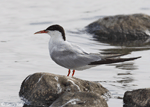 |
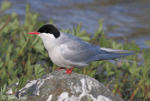 |
 |
| Common Tern | Arctic Tern | Arctic Tern |
Conservation Status:
Has declined in portions of its range, probably due to habitat loss. However, overall populations are stable or may actually be increasing, and they are found across a very broad geographic range. The IUCN considers the Forster's Tern to be a species of "Least Concern".
Further Information:
Photo Information:
June 23rd, 2005 - Assateague Island in Virginia - Terry Sohl
Additional Photos:
Click on the image chips or text links below for additional, higher-resolution Forster's Tern photos.
Audio File Credits
-
1David Darrell-Lambert. Recorded in Essex County, Ontario on May 14th, 2019. Original file and recording from xeno-canto.
-
2Paul Marvin. Recorded in Barton County, Kansas on May 24th, 2015. Original file and recording from xeno-canto.
| Click on the map below for a higher-resolution view |
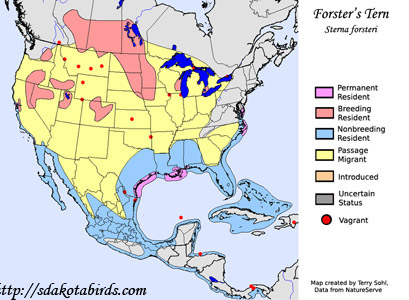 |
| South Dakota Status: Common migrant and summer resident in the eastern part of the state and in the northern Sand Hills on the southern edge of the state. Uncommon migrant and summer visitor elsewhere in the state. |
Additional Forster's Tern Photos
Click for a higher-resolution version of these photos
